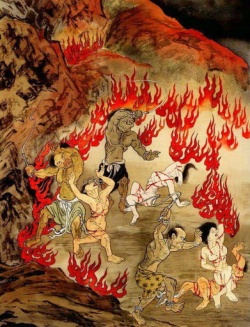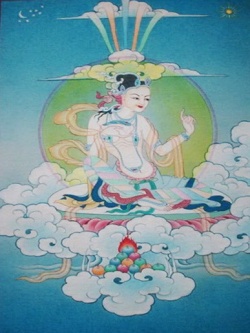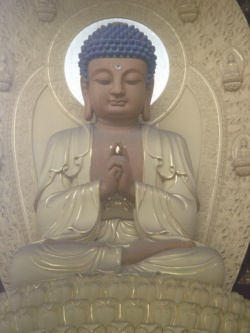The Kasyapa Brothers
The three Kasyapa brothers had a thousand disciples. Five hundred were with Uruvilva Kasyapa. Uruvilva means “papaya grove,” for it is said that he cultivated in a papaya grove. Some accounts claim that he had a lump on his chest which resembled a papaya, some describing it as concave, and some as convex! What is probable is that, liking to eat papayas, he cultivated in a papaya grove and in time a papaya grew on his chest. Papayas are good for curing illnesses of the lungs.
Uruvilva Kasyapa had two brothers, Gaya, meaning “city”23 or “elephant head mountain,” and Nadi, meaning “river.”25 The two brothers had five hundred disciples between them, and so the three brothers had a total of one thousand disciples. The Buddha first taught and crossed over the five Bhikshus in the Deer Park. Then he considered who to cross over next. Seeing that the potential of the three Kasyapa brothers had matured, he went to the dwelling of Uruvilva Kasyapa. He could not, however, simply say, “I have come to save you, Uruvilva Kasyapa.
Do you believe that?” He had to employ a clever expedient device and so he said, “It’s late and I can’t travel any farther. May I stay on here?” Uruvilva Kasyapa, a powerful fire worshipper, saw the Buddha and thought, “Why is he so special?” Try as he might, he couldn’t figure the Buddha out. “Strange,” he thought, “I can see anyone else’s background just by looking. Why can’t I see his?” Finally he said to the Buddha, “Very well, you may stay here,” and he put him in a cave where Uruvilva Kasyapa’s protector, a dragon, lived.
The dragon was extremely fierce and scorched to death anyone who came near him. In the middle of the night, the dragon tried to burn the Buddha, but the Buddha had entered the fire-light samadhi and couldn’t be burned. The Buddha put the dragon in his bowl. More than likely, he didn’t have to trick him by saying, “You can only make fire, you can’t jump into my bowl,” as the Sixth Patriarch would later speak to another dragon: “You can only manifest a big body, not a small one.” The Buddha used a very natural dharma to get the dragon into his bowl. Then he explained the dharma to him and the dragon took refuge.
Seeing such spiritual penetrations and transformation, Kasyapa knew that his own virtue was not as great as the Buddha’s. Thereupon, he took refuge and instructed his five hundred disciples to do the same. Soon after leaving home, they gave proof to the sagely fruit.
Kasyapa’s two brothers were also fire-worshippers, but when they saw that their brother had become a Bhikshu, they wanted to leave home as well. They did, and, along with their five hundred disciples, they soon gave proof to the sagely fruit. That makes one thousand two hundred and fifty-five disciples. Out of gratitude for the Buddha’s deep kindness and his teaching, they were the Buddha’s constant followers. No matter where the Buddha went, they accompanied him and protected the assembly.
For example, here we lecture on the Sutras and those who come to listen protect the assembly. Even though they already understand the doctrines, they still take time from their busy schedules to come and listen.
…all great Arhats whom the assembly knew and recognized... Arhat, a Sanskrit word, has three meanings which correspond to the three meanings of the word Bhikshu, because being a Bhikshu is the cause of attaining Arhatship, and Arhatship is the result of cultivation as a Bhikshu. It’s a matter of cause and effect.
An Arhat is:
1) Worthy of offerings. On the causal ground, a Bhikshu is a seeker of alms food, and in the result he is worthy of the offerings of gods and men.
2) One without birth. A Bhikshu frightens Mara, and in the result, as an Arhat, he undergoes no further birth. 3) A slayer of thieves. On the causal ground, a Bhikshu destroys evil, and in the result, as an Arhat, he has slain the thieves of ignorance and affliction.
On the causal ground, the Bhikshu frightens the demons of the five skandhas, the afflictions, and death. Death is also a demon. Some cultivators practice diligently, yet when they fall sick and confront death, they are afraid. “I’m going to die!” they cry, turned by the demon of death. Real cultivators fear nothing. They are not afraid of life and they are not afraid of death. Life and death are the same.
Death and life are not different. There is no distinction between them. If while alive cultivators can be as if dead, they will have no thoughts of desire. How can one have desire, greed, hate, stupidity, pride, or doubt as a dead man? When one arrives at this state there are no afflictions, no troubles at all. This is true happiness.
This state is not easy to attain, however, on the other hand, it is not difficult either. If you want to, you can do it. The Kasyapa Brothers
For example, when one of my disciples became extremely sick, he said to me repeatedly, “I’m really suffering.” I said, “The more suffering you undergo, the better. The more you suffer the more you will understand.” One day it seemed as if he had died. He went to a happy place full of people. “Happiness is happiness,” he said, “but I want to see my teacher.”
“Who is your teacher?” the people asked.
As soon as they heard his teacher’s name they were unhappy. “You can’t see your teacher here,” they said. “Then I’m leaving,” he said, and came back; he didn’t die after all. You might say he has conquered the demon of death. Subsequently, his skill has increased greatly.
…whom the assembly knew and recognized…These arhats were all very famous and their virtue was respected by the entire population. Everyone knew their names and recognized their faces.


